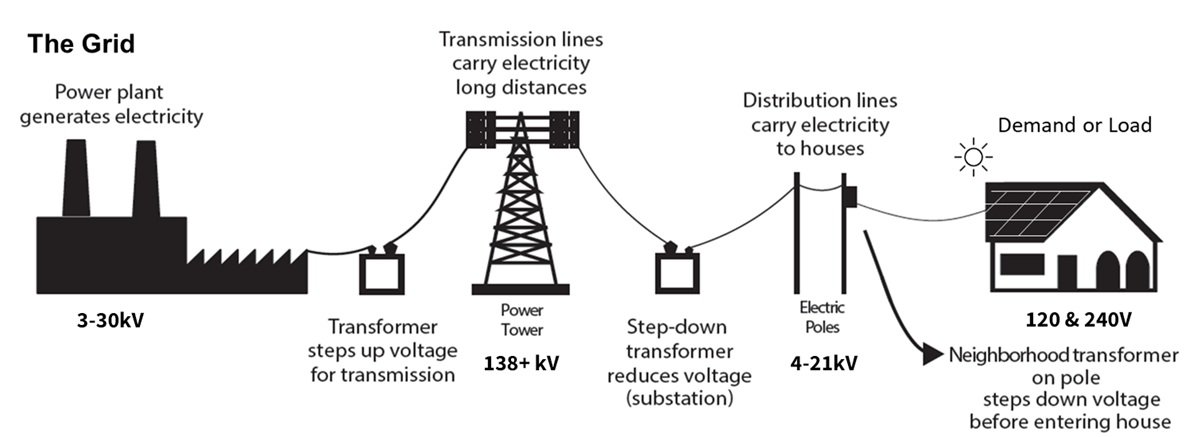Simply put, the electric power grid delivers or transmits electricity from a generation station, such as a wind turbine or solar photovoltaic (PV) panel, to customers, undergoing stages that include regional transmission, voltage increases and reductions, and local distribution. After leaving the generating station, electricity enters a sub-station where a step-up transformer raises the voltage to extremely high levels to allow for long-distance transmission. High-voltage electricity is then transferred to local substations, where a step-down transformer reduces voltage to levels suitable for customer use. Distribution lines carry this lower-voltage electricity from local substations to customer homes and businesses. Energy electric generation and battery storage that are located at the site of a home or business are called “distributed” or “behind-the-meter” systems. Rooftop solar and other behind-the-meter resources can help reduce reliance on grid-based power plants and on the transmission infrastructure needed to distribute electricity across long distances.
Source: Stanford University. N.d. The Grid: Electricity Transmission, Industry, and Markets. Available at: https://understand-energy.stanford.edu/energy-currencies/electricity-grid
As renewable energy gets integrated into this grid system, several engineering benefits and challenges can arise. Wind turbines, which generated 10.25 percent of the total U.S. power supply in 2022, convert wind energy into electricity by rotating blades to spin a generator. One of the benefits of turbines is that, after being disconnected from the energy source, they keep spinning with inertia for some time. This lag provides operators with time to address system failures before total loss of power.
One of wind energy’s biggest engineering challenges, however, is designing turbine blades to efficiently extract energy from air. Predicting the flow of air around an object is challenging, and the blades must withstand the stress they are subject to while rotating. In addition, the strength of the wind cannot be controlled to increase or decrease power generation as needed. Wind energy is typically transported from sparsely populated open areas where the wind blows more easily, to dense urban areas with high demand for power. The longer the distance from electric customers, the more electricity is lost from the lines.
Solar PV panels absorb sunlight through conductive metal contact lines on the solar panels. The energy then flows through the panels as an electrical current, delivering power to the home, businesses, or electric grid. Solar panels can be deployed at a small scale close to areas of customer electric demand, such as on the rooftops of residential homes.
Solar cells are not, however, very efficient, converting just 20 percent of the sunlight they absorb into electric power. Furthermore, solar cells produce direct current (DC) electricity, which means that the electrical current flows in only one direction within the circuit. Most home and commercial electric use—such as lights and appliances—requires alternating current (AC) electricity. Solar energy must be converted from DC to AC using an inverter before it can be integrated into the electrical grid or used in homes and businesses.
On very windy or very sunny days, renewables can overproduce electricity resulting in spikes in electric production that can cause issues controlling frequency and voltage on the grid. Both are important characteristics for a functioning electric system. Aging transmission lines and substations might not be able to handle the energy spikes, increasing risks of outages, or may require disconnecting energy generators to avoid system-wide problems. Surplus electricity can be stored in batteries and later released, reducing the risk of system outages during periods of low production. “Smart grid” technologies, such as advanced metering and automated control systems, can help monitor grid stability in real-time, optimize power flow, and predict outages. Relocating transmission wires underground or upgrading poles and wires to sturdier materials can make the electric grid more resistant to damage from severe weather or other threats. These strategies—storage, smart grids, and infrastructure upgrades—enhance grid resilience, reliability, and stability for a clean energy future.


